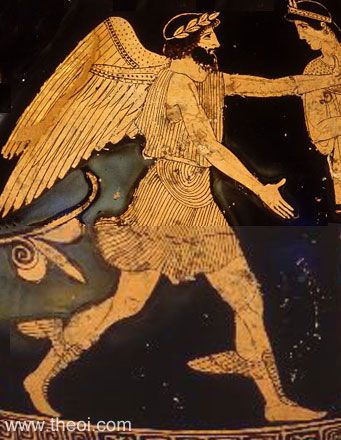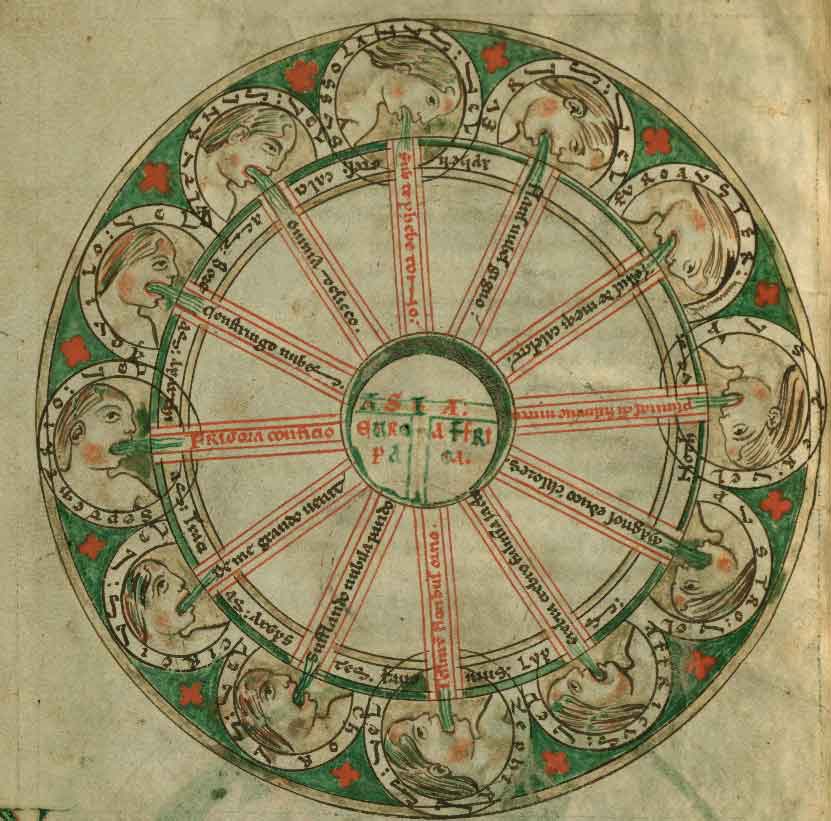By it Boreas has seen the manor of Auster;
Original French: Par elle Boreas a veu le manoir de Auſter:
Modern French: Par elle Boreas a veu le manoir de Auster:
Among the far-flung places that are brought together by the use of Pantagruelion to weave the sails of ships.
Notes
Boreas

Detail of Boreas, the winged god of the north wind, from a painting depicting his pursuit of the Athenian princess Oreithyia. He is shown with winged shoulders and feet.
Diagram of the Winds
The winds
Veteres quattuor omnino servavere per totidem mundi partes (ideo nec Homerus plures nominat) hebeti, ut mox iudicatum est, ratione; secuta aetas octo addidit nimis subtili atque concisa. proximis inter utramque media placuit ad brevem ex numerosa additis quattuor. sunt ergo bini in quattuor caeli partibus: ab oriente aequinoctiali Subsolanus, ab oriente brumali Volturnus (illum Apelioten, hunc Graeci Eurum appellant); a meridie Auster et ab occasu brumali Africus (Notum et Liba nominant); ab occasu aequinoctiali Favonius, ab occasu solstitiali Corus (Zephyrum et Argesten vocant); a septentrionibus Septentrio, interque eum et exortum solstitialem Aquilo (Aparctias et Boreas).
The ancients noticed four winds in all, corresponding to the four quarters of the world (this is the reason why even Homer mentions no more)—a dull-witted system, as it was soon afterwards considered; the following age added eight—this system on the other hand was too subtle and meticulous. Their successors adopted a compromise, adding to the short list four winds from the long one. There are consequently two winds in each of the four quarters of the heaven: Subsolanus blowing from the equinoctial sunrise (E). and Vulturnus from the winter sunrise (S.E.)—the former designated by the Greeks Apeliotes, the latter Eurus; Auster from the sun at midday (S.) and Africus from the winter sunset (S.W.)—named in Greek Notus and Libs; Favonius from the equinoctial sunset (W.), Corus from the sunset at the solstice (N.W.)—these the Greeks call Zephyr and Argestes; Septentrio from the North and Aquilo between him and sunrise at the solstice (N.E.)—called in Greek Aparctias and Boreas.
auster
Nom que les Latins donnaient au vent du midi. Du grec dessécher : vent desséchant, brûlant.
Boreas, Auster, Eurus, Zephire
Boreas et Auster désignent le nord et le sud; Eurus et Zéphyre, l’est et l’ouest.
auster
Poét. Nom donné par les Latins au vent du midi chaud et humide, parfois violent.
Le pluvieux, l’humide, l’impétueux Auster (Ac. 1835-1878)
Au milieu du printemps, le fougueux aquilon, Sur les monts sourcilleux qui bordent l’horison, Conservoit son empire; et, du haut des montagnes, Le nébuleux hiver menaçoit les campagnes. Mais l’Auster bienfaisant a vaincu les frimats, Et l’hiver en grondant fuit dans d’autres climats. Michaud, Le Printemps d’un proscrit,1803, p. 91.
− MYTH. Un des vents fils de l’Aurore et d’Astréus. (Ac. Compl. 1842, Lar. 19e et Nouv. Lar. ill.), représenté sous la forme d’un vieillard robuste couronné de nuages.
Boreas
Boreas was the purple-winged god of the north wind, one of the four directional Anemoi (wind-gods). He was also the god of winter, who swept down from the cold northern mountains of Thrake, chilling the air with his icy breath. To the north, beyond his mountain home, lay Hyperborea, a land of eternal spring which was never touched by the god’s cold wind.
Anemoi
The Anemoi were the gods of the four directional winds–Boreas the North-Wind, Zephryos the West-Wind, Notos the South-Wind, and Euros the East-Wind. They were closely connected with the seasons : Boreas was the cold breath of winter, Zephyros the god of spring breezes, and Notos the god of summer rain-storms.
The Wind-Gods were represented as either winged, man-shaped gods, or horse-like divinities, which grazed the shores of the river Okeanos or were stabled in the caverns of Aiolos Hippotades, “the Horse-Reiner,” king of the winds.
Homer and Hesiod distinguish the four seasonal Anemoi (Winds) from the Anemoi Thuellai, (Storms-Winds and Hurricanes). The latter were housed in the caverns of Aiolos or the pit of Tartaros where they were guarded by the Hekatonkheires. Later authors, however, blurred the distinction between the two.
The female counterparts of the Anemoi were the Aellai Harpyiai (or Harpies). Mating, with these they sired swift, immortal horses.
Notos or Auster
Notos (or Notus) was the god of the South Wind, one of the four Anemoi (Wind-Gods). He was the wet, storm-bringing wind of late summer and early autumn. Notos dwelt in Aithiopia, the southernmost realm in the geography of myth.
[Poseidon] massed the clouds, clutched his trident and churned the ocean up; he roused all the blasts of all the Winds and swathed earth and sea alike in clouds; down from the sky rushed the dark. Euros (East Wind) and Notos (South Wind) clashed together, the stormy Zephyros (West Wind) and the sky-born billow-driving Boreas (North Wind).
Homer, Odyssey 5. 291 ff (trans. Shewring) (Greek epic C8th B.C.)
And Eos (Dawn) bare to Astraios (the Starry) the strong-hearted Anemoi (Winds), brightening Zephyrus (West Wind), and Boreas (North Wind), headlong in his course, and Notos (South Wind)–a goddess mating in love with a god.
Hesiod, Theogony 378 ff (trans. Evelyn-White) (Greek epic C8th or C7th B.C.)
Horse-keepers frequently testify to mares being impregnated by the Wind, and to their galloping against Notos (the South Wind) or Borras (the North). And the same poet [Homer] knew this when he said “Of them was Boreas enamoured as they pastured.” Aristotle too, borrowing (as I think) from him, said that they rush away in frenzy straight in the face of the aforesaid Autai (Winds).
Aelian, On Animals 4. 6 (trans. Scholfield) (Greek natural history C2nd A.D.)
Lucifer (the Morning Star) [Eosphoros] revealed the shining day, night fled, Eurus (the East Wind) fell, the rain-clouds rose, steady Auster (South Wind) [Notos] blew.
Ovid, Metamorphoses 8. 1 ff
“The vines offered hope Auster [Notos the South Wind] blackens the sky and sudden rain ravishes their leaves.”
Ovid, Fasti 5. 323 ff (trans.Boyle) (Roman poetry C1st B.C. to C1st A.D.)
